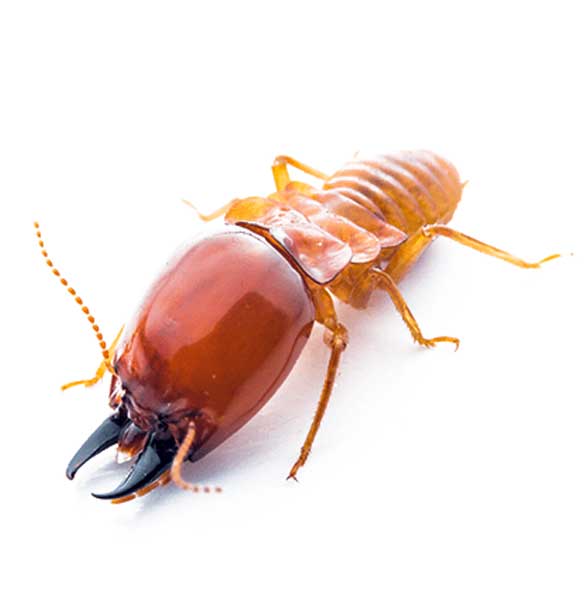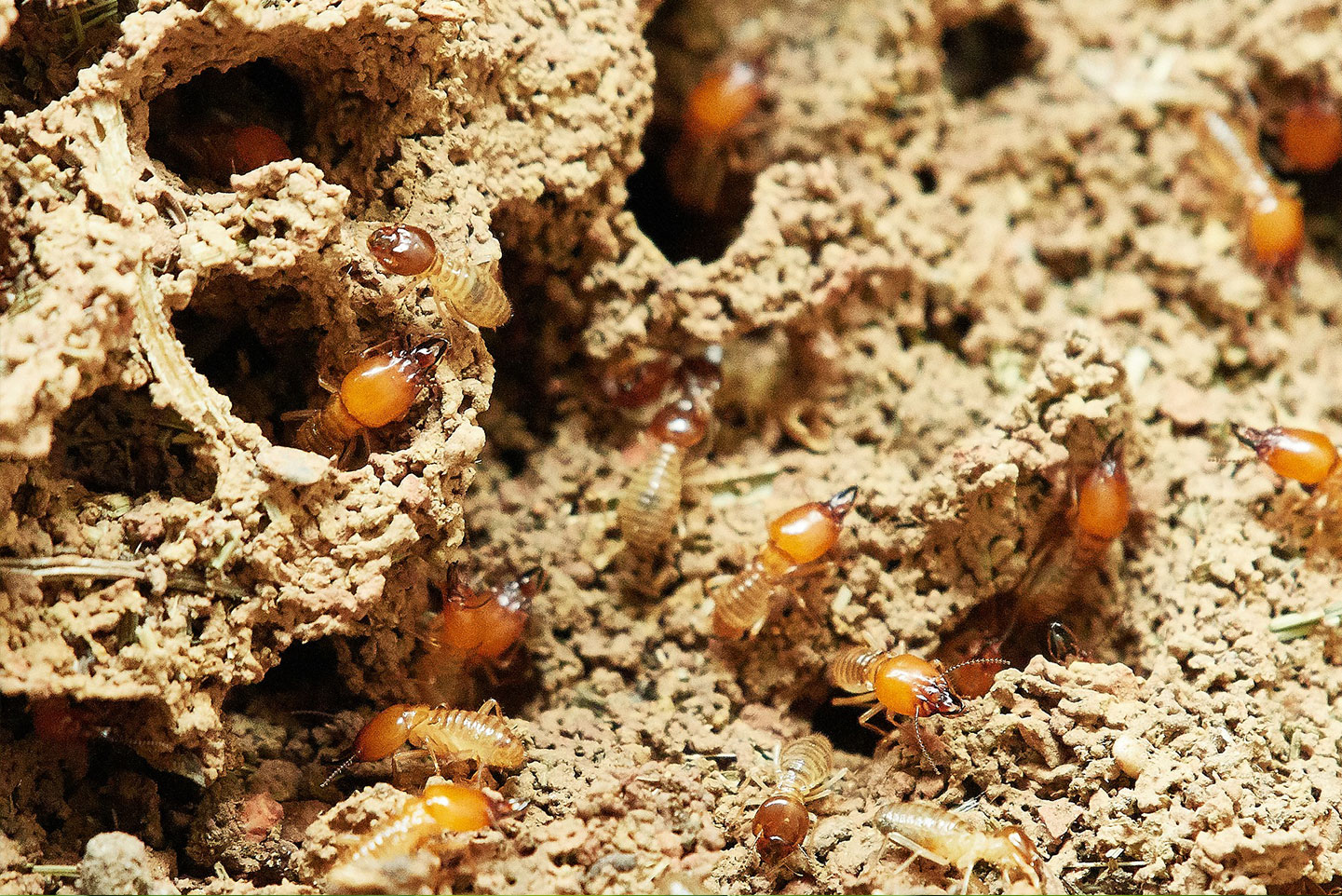(ISOPTERA)
Description
Termites are typically between 1/4 and 1/2 inch long, although the kings and queens are larger, sometimes over 1 inch long. They have soft bodies with straight antennae. They range from white to light brown. Worker termites often appear lighter, while swarming termites are often darker.
They have three body segments and six legs. They may also have wings, and the wings are all about the same length. They have strong mouths to chew seeds, wood, and leaves.

Additional Information
Habits & Behavior

Termites are social insects in that they have an organized structure in a colony. They have a king, queen, and various worker termites who each have a function. Each colony has its own characteristics.
Termites are actually blind, so they communicate through vibrations and chemical signals, called pheromones. Termites may secrete pheromones to mark the trail to food or alert the colony to danger.
Swarming is a common termite behavior. Termites swarm in order to mate and start new colonies. Termites do not usually fly much, though, and will often shed their wings.
Termites usually are cryptic, meaning that they don’t come out into the open. They tend to come out at night, when it is more humid and there are light sources.
Most species of termites live in underground nests; however, some species build elaborate mounds or mud tubes. Mounds are made from termite feces, plant material and soil. There may also be above-ground nests. Certain species, such as subterranean termites and dampwood termites, require plenty of moisture for survival.
Food
Termites are detritivores, which means they eat dead plants. They prefer cellulose, which is obtained from wood, grass, leaves, humus, and the manure of herbivorous animals. This also includes paper, cotton, cardboard, and other materials of vegetative origin. Most termites feed on decayed wood. However, they tend to avoid cedar, which is somewhat naturally resistant to termites. They will also avoid pressure-treated wood.
Interestingly, termites actually have bacterial protozoa living in their stomachs, and these single-celled animals are digesting their food for them. Termites can chew through plastic to get to wood and other food sources. However, they cannot chew through concrete.
Termites cannot live in dry areas. They need moisture to survive, so they are commonly found in damp soil and on moist wood.
Reproduction
Not all termites can breed and reproduce. The king and queen termites are at the center of the termite life cycle and are the ones responsible for reproduction.
The life cycle of the termite begins with a mating flight. This is when winged reproductive males and females will leave their established colonies. They will start swarming and procreating. After fertilization, winged termites will shed their wings. These termites will form new colonies and become the king or queen termites of their newly established colonies.
After the fertilized queen lays her eggs, they hatch into larvae, which are pale white in color. The larvae then molt and go on to develop into workers, soldiers, and reproductive termites. Reproductive termites are important. Without them, the colony will eventually collapse.
Workers and soldiers live approximately 1-2 years. Queen termites can survive for more than a decade under optimal climate conditions.
Signs
Do you have termites in your home? Here are some signs of termite activity:
- You see termites. This is the most obvious sign you have termites. Swarmers will fly around primarily at night, but sometimes they may be out during the day. The swarming activity may occur around your home or even inside it.
- Hollow wood. If you knock on the wood and it sounds hollow or papery, you might have termite activity. This is because termites often eat wood from the inside out. This means the interior of the wood is being eaten away in part or in its entirety.
- Damaged flooring and ceilings. Termites can eat away at wood inside the home, as well as baseboards and laminate flooring. Damaged flooring may blister and sag in some places. If the floor seems spongier than usual, termites may be close by. Cracks in the walls and ceilings may indicate termite activity.
- Mud tubes. Subterranean termites will often create mud tubes, which help them get from the ground to a food source. They are found attached to building structures and are usually close to the foundation. They are built from soil and termite droppings and serve as protection for termites.
- Strange noises. You may hear odd sounds in your home. Worker termites who love to chew on wood, and they can be noisy eaters. You may hear clicking sounds coming from the walls. Termite soldiers may bang their heads and shake their bodies when the colony is threatened.
Dangers

Termites are known for destroying property, which can be costly to repair. Termites do not spread diseases and do not usually bite or sting humans, unlike other insects. Still, termites can still make people sick. They can cause skin irritation and allergies. Exposure to their droppings can cause allergic reactions. Also, termites can spread allergens throughout the home, which can cause respiratory infections and even asthma attacks. A person with open wounds can experience fungal infections.
Contact Us Today
Termites are nasty insects that can cause a lot of damage to a home, business, or other building. If you notice signs of them, seek help right away.
The professionals at Stride Pest Control can help eradicate termites. We are known for our quality and customer service. We use only the best products, application methods, and safety protocols in the industry. To schedule an appointment, call (512) 777-1339 (Austin) or (210) 547-8410 (San Antonio) or fill out the online form.
Years a queen termite can live
25+
Structural damage in billions caused each year
$5B
Average number of termites in a nest
2k-4k
Number of termite casts (types)
3
Get a FREE Consultation


